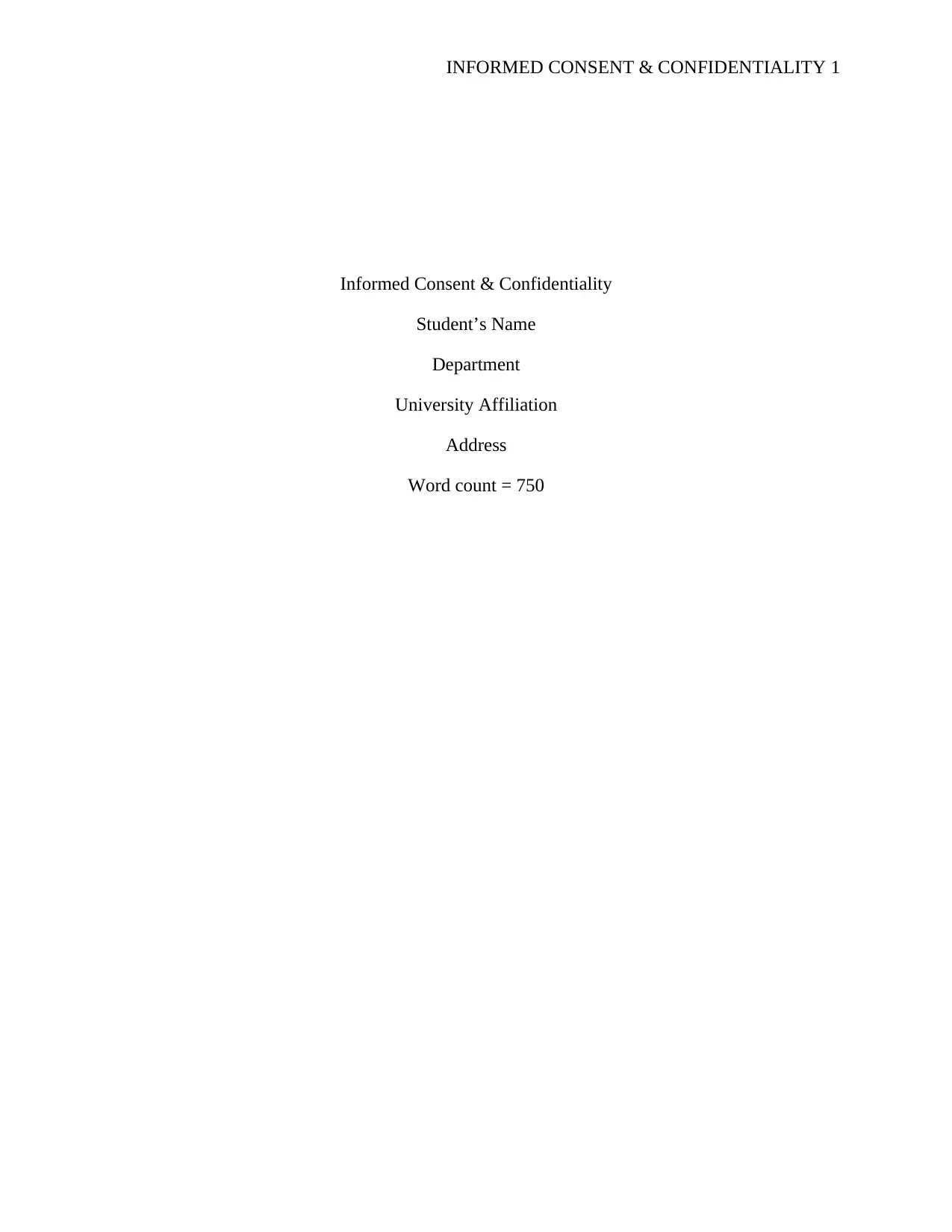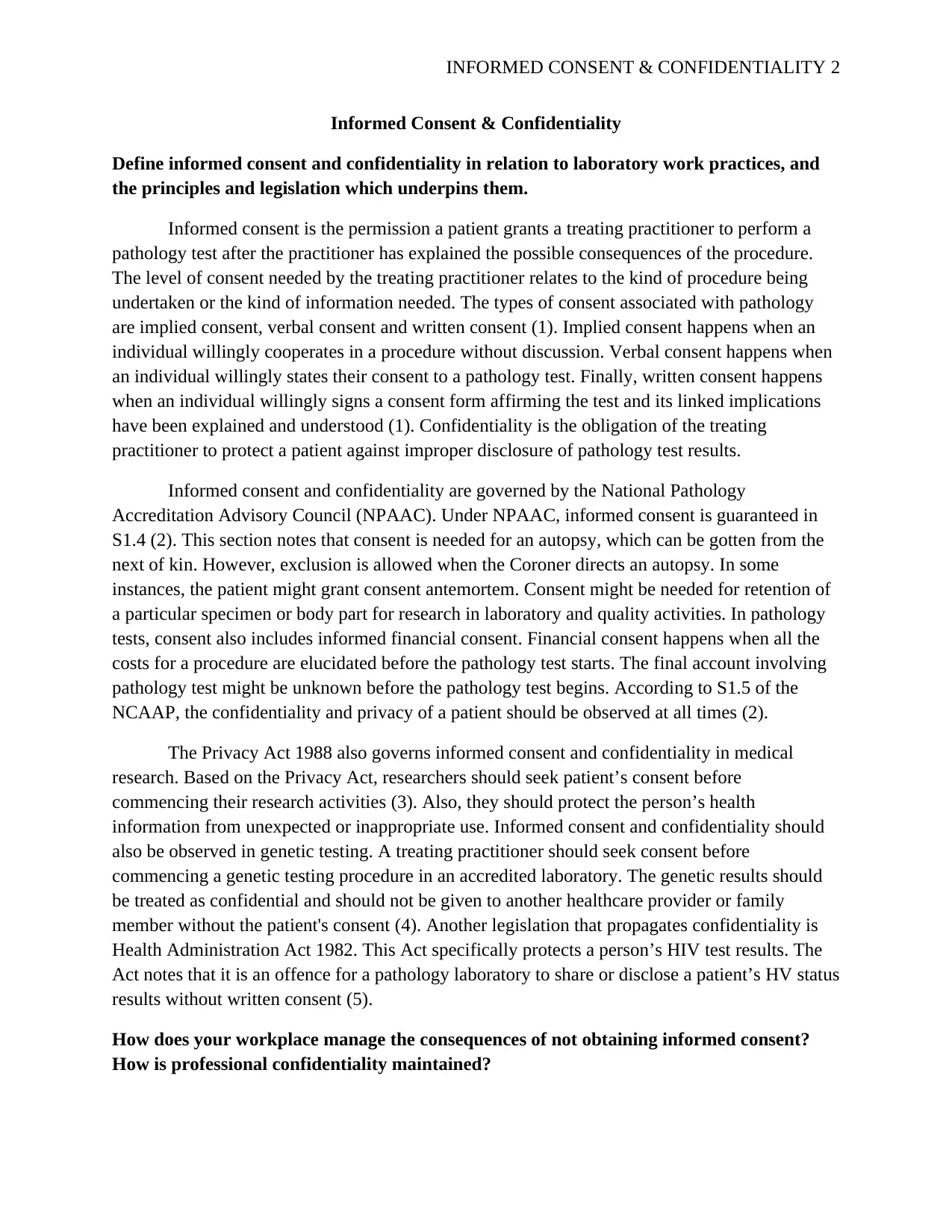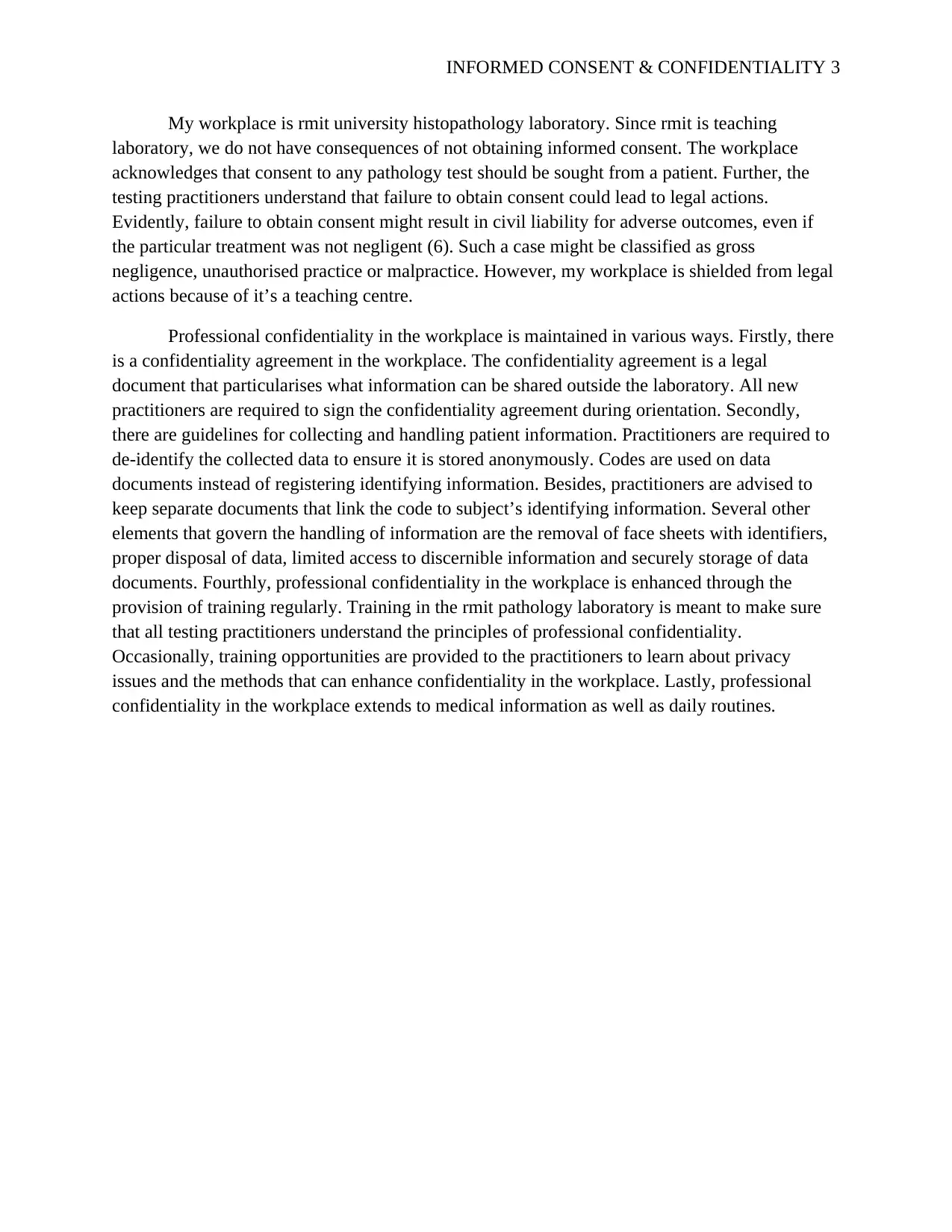Informed Consent & Confidentiality: Principles and Legislation Report
VerifiedAdded on 2020/03/15
|4
|1100
|174
Report
AI Summary
This report defines informed consent and confidentiality within the context of laboratory work practices, emphasizing the importance of patient rights and data protection. It outlines the legal and ethical frameworks, including the National Pathology Accreditation Advisory Council (NPAAC), the Privacy Act 1988, and the Health Administration Act 1982, that govern these principles. The report explores various types of consent (implied, verbal, written) and the implications of non-compliance. Furthermore, it examines how a specific workplace, RMIT University's histopathology laboratory, manages informed consent and maintains professional confidentiality through confidentiality agreements, data handling guidelines, training programs, and adherence to privacy protocols. The report concludes by highlighting the significance of these practices in ensuring ethical and legally sound healthcare delivery.

INFORMED CONSENT & CONFIDENTIALITY 1
Informed Consent & Confidentiality
Student’s Name
Department
University Affiliation
Address
Word count = 750
Informed Consent & Confidentiality
Student’s Name
Department
University Affiliation
Address
Word count = 750
Paraphrase This Document
Need a fresh take? Get an instant paraphrase of this document with our AI Paraphraser

INFORMED CONSENT & CONFIDENTIALITY 2
Informed Consent & Confidentiality
Define informed consent and confidentiality in relation to laboratory work practices, and
the principles and legislation which underpins them.
Informed consent is the permission a patient grants a treating practitioner to perform a
pathology test after the practitioner has explained the possible consequences of the procedure.
The level of consent needed by the treating practitioner relates to the kind of procedure being
undertaken or the kind of information needed. The types of consent associated with pathology
are implied consent, verbal consent and written consent (1). Implied consent happens when an
individual willingly cooperates in a procedure without discussion. Verbal consent happens when
an individual willingly states their consent to a pathology test. Finally, written consent happens
when an individual willingly signs a consent form affirming the test and its linked implications
have been explained and understood (1). Confidentiality is the obligation of the treating
practitioner to protect a patient against improper disclosure of pathology test results.
Informed consent and confidentiality are governed by the National Pathology
Accreditation Advisory Council (NPAAC). Under NPAAC, informed consent is guaranteed in
S1.4 (2). This section notes that consent is needed for an autopsy, which can be gotten from the
next of kin. However, exclusion is allowed when the Coroner directs an autopsy. In some
instances, the patient might grant consent antemortem. Consent might be needed for retention of
a particular specimen or body part for research in laboratory and quality activities. In pathology
tests, consent also includes informed financial consent. Financial consent happens when all the
costs for a procedure are elucidated before the pathology test starts. The final account involving
pathology test might be unknown before the pathology test begins. According to S1.5 of the
NCAAP, the confidentiality and privacy of a patient should be observed at all times (2).
The Privacy Act 1988 also governs informed consent and confidentiality in medical
research. Based on the Privacy Act, researchers should seek patient’s consent before
commencing their research activities (3). Also, they should protect the person’s health
information from unexpected or inappropriate use. Informed consent and confidentiality should
also be observed in genetic testing. A treating practitioner should seek consent before
commencing a genetic testing procedure in an accredited laboratory. The genetic results should
be treated as confidential and should not be given to another healthcare provider or family
member without the patient's consent (4). Another legislation that propagates confidentiality is
Health Administration Act 1982. This Act specifically protects a person’s HIV test results. The
Act notes that it is an offence for a pathology laboratory to share or disclose a patient’s HV status
results without written consent (5).
How does your workplace manage the consequences of not obtaining informed consent?
How is professional confidentiality maintained?
Informed Consent & Confidentiality
Define informed consent and confidentiality in relation to laboratory work practices, and
the principles and legislation which underpins them.
Informed consent is the permission a patient grants a treating practitioner to perform a
pathology test after the practitioner has explained the possible consequences of the procedure.
The level of consent needed by the treating practitioner relates to the kind of procedure being
undertaken or the kind of information needed. The types of consent associated with pathology
are implied consent, verbal consent and written consent (1). Implied consent happens when an
individual willingly cooperates in a procedure without discussion. Verbal consent happens when
an individual willingly states their consent to a pathology test. Finally, written consent happens
when an individual willingly signs a consent form affirming the test and its linked implications
have been explained and understood (1). Confidentiality is the obligation of the treating
practitioner to protect a patient against improper disclosure of pathology test results.
Informed consent and confidentiality are governed by the National Pathology
Accreditation Advisory Council (NPAAC). Under NPAAC, informed consent is guaranteed in
S1.4 (2). This section notes that consent is needed for an autopsy, which can be gotten from the
next of kin. However, exclusion is allowed when the Coroner directs an autopsy. In some
instances, the patient might grant consent antemortem. Consent might be needed for retention of
a particular specimen or body part for research in laboratory and quality activities. In pathology
tests, consent also includes informed financial consent. Financial consent happens when all the
costs for a procedure are elucidated before the pathology test starts. The final account involving
pathology test might be unknown before the pathology test begins. According to S1.5 of the
NCAAP, the confidentiality and privacy of a patient should be observed at all times (2).
The Privacy Act 1988 also governs informed consent and confidentiality in medical
research. Based on the Privacy Act, researchers should seek patient’s consent before
commencing their research activities (3). Also, they should protect the person’s health
information from unexpected or inappropriate use. Informed consent and confidentiality should
also be observed in genetic testing. A treating practitioner should seek consent before
commencing a genetic testing procedure in an accredited laboratory. The genetic results should
be treated as confidential and should not be given to another healthcare provider or family
member without the patient's consent (4). Another legislation that propagates confidentiality is
Health Administration Act 1982. This Act specifically protects a person’s HIV test results. The
Act notes that it is an offence for a pathology laboratory to share or disclose a patient’s HV status
results without written consent (5).
How does your workplace manage the consequences of not obtaining informed consent?
How is professional confidentiality maintained?

INFORMED CONSENT & CONFIDENTIALITY 3
My workplace is rmit university histopathology laboratory. Since rmit is teaching
laboratory, we do not have consequences of not obtaining informed consent. The workplace
acknowledges that consent to any pathology test should be sought from a patient. Further, the
testing practitioners understand that failure to obtain consent could lead to legal actions.
Evidently, failure to obtain consent might result in civil liability for adverse outcomes, even if
the particular treatment was not negligent (6). Such a case might be classified as gross
negligence, unauthorised practice or malpractice. However, my workplace is shielded from legal
actions because of it’s a teaching centre.
Professional confidentiality in the workplace is maintained in various ways. Firstly, there
is a confidentiality agreement in the workplace. The confidentiality agreement is a legal
document that particularises what information can be shared outside the laboratory. All new
practitioners are required to sign the confidentiality agreement during orientation. Secondly,
there are guidelines for collecting and handling patient information. Practitioners are required to
de-identify the collected data to ensure it is stored anonymously. Codes are used on data
documents instead of registering identifying information. Besides, practitioners are advised to
keep separate documents that link the code to subject’s identifying information. Several other
elements that govern the handling of information are the removal of face sheets with identifiers,
proper disposal of data, limited access to discernible information and securely storage of data
documents. Fourthly, professional confidentiality in the workplace is enhanced through the
provision of training regularly. Training in the rmit pathology laboratory is meant to make sure
that all testing practitioners understand the principles of professional confidentiality.
Occasionally, training opportunities are provided to the practitioners to learn about privacy
issues and the methods that can enhance confidentiality in the workplace. Lastly, professional
confidentiality in the workplace extends to medical information as well as daily routines.
My workplace is rmit university histopathology laboratory. Since rmit is teaching
laboratory, we do not have consequences of not obtaining informed consent. The workplace
acknowledges that consent to any pathology test should be sought from a patient. Further, the
testing practitioners understand that failure to obtain consent could lead to legal actions.
Evidently, failure to obtain consent might result in civil liability for adverse outcomes, even if
the particular treatment was not negligent (6). Such a case might be classified as gross
negligence, unauthorised practice or malpractice. However, my workplace is shielded from legal
actions because of it’s a teaching centre.
Professional confidentiality in the workplace is maintained in various ways. Firstly, there
is a confidentiality agreement in the workplace. The confidentiality agreement is a legal
document that particularises what information can be shared outside the laboratory. All new
practitioners are required to sign the confidentiality agreement during orientation. Secondly,
there are guidelines for collecting and handling patient information. Practitioners are required to
de-identify the collected data to ensure it is stored anonymously. Codes are used on data
documents instead of registering identifying information. Besides, practitioners are advised to
keep separate documents that link the code to subject’s identifying information. Several other
elements that govern the handling of information are the removal of face sheets with identifiers,
proper disposal of data, limited access to discernible information and securely storage of data
documents. Fourthly, professional confidentiality in the workplace is enhanced through the
provision of training regularly. Training in the rmit pathology laboratory is meant to make sure
that all testing practitioners understand the principles of professional confidentiality.
Occasionally, training opportunities are provided to the practitioners to learn about privacy
issues and the methods that can enhance confidentiality in the workplace. Lastly, professional
confidentiality in the workplace extends to medical information as well as daily routines.
⊘ This is a preview!⊘
Do you want full access?
Subscribe today to unlock all pages.

Trusted by 1+ million students worldwide

INFORMED CONSENT & CONFIDENTIALITY 4
References
x
1. Department of Health. Pathology - The Facts. Consent - What you need to know. [Online].;
2013 [cited 2017 10 3. Available from:
http://www.health.gov.au/internet/publications/publishing.nsf/Content/qupp-benefits-
and-risks-for-consumers-of-pathology-testing~qupp-consent.
2. Australian Government Department of Health. Requirements for medical pathology services.
Canberra : National Pathology Accreditation Advisory Council (NPAAC), Department
of Health; 2013. Report No.: NPAAC Tier 2 Document.
3. OAIC. Health information and medical research. [Online].; 2017 [cited 2017 10 3. Available
from: https://www.oaic.gov.au/privacy-law/privacy-act/health-and-medical-
research#medical-research.
4. Royal College of Pathologist of Australia (RCPA). Pathology: The Facts. [Online].; n.d. [cited
2017 10 3. Available from: https://www.rcpa.edu.au/Library/Fact-Sheets/Pathology-
The-Facts/Docs/Path-Fcts-Booklt.
5. HIV Legal. Privacy and Confidentiality. [Online].; 2013 [cited 2017 10 3. Available from:
http://hivlegal.ashm.org.au/index.php/guide-to-australian-hiv-laws-and-policies-for-
healthcare-professionals/privacy-and-confidentiality.
6. Australia Law Reform Commission (ALRC). Informed consent to medical treatment.
[Online].; 2017 [cited 2017 10 3. Available from:
https://www.alrc.gov.au/publications/10-review-state-and-territory-legislation/
informed-consent-medical-treatment#_ftn36.
x
References
x
1. Department of Health. Pathology - The Facts. Consent - What you need to know. [Online].;
2013 [cited 2017 10 3. Available from:
http://www.health.gov.au/internet/publications/publishing.nsf/Content/qupp-benefits-
and-risks-for-consumers-of-pathology-testing~qupp-consent.
2. Australian Government Department of Health. Requirements for medical pathology services.
Canberra : National Pathology Accreditation Advisory Council (NPAAC), Department
of Health; 2013. Report No.: NPAAC Tier 2 Document.
3. OAIC. Health information and medical research. [Online].; 2017 [cited 2017 10 3. Available
from: https://www.oaic.gov.au/privacy-law/privacy-act/health-and-medical-
research#medical-research.
4. Royal College of Pathologist of Australia (RCPA). Pathology: The Facts. [Online].; n.d. [cited
2017 10 3. Available from: https://www.rcpa.edu.au/Library/Fact-Sheets/Pathology-
The-Facts/Docs/Path-Fcts-Booklt.
5. HIV Legal. Privacy and Confidentiality. [Online].; 2013 [cited 2017 10 3. Available from:
http://hivlegal.ashm.org.au/index.php/guide-to-australian-hiv-laws-and-policies-for-
healthcare-professionals/privacy-and-confidentiality.
6. Australia Law Reform Commission (ALRC). Informed consent to medical treatment.
[Online].; 2017 [cited 2017 10 3. Available from:
https://www.alrc.gov.au/publications/10-review-state-and-territory-legislation/
informed-consent-medical-treatment#_ftn36.
x
1 out of 4
Related Documents
Your All-in-One AI-Powered Toolkit for Academic Success.
+13062052269
info@desklib.com
Available 24*7 on WhatsApp / Email
![[object Object]](/_next/static/media/star-bottom.7253800d.svg)
Unlock your academic potential
Copyright © 2020–2025 A2Z Services. All Rights Reserved. Developed and managed by ZUCOL.




